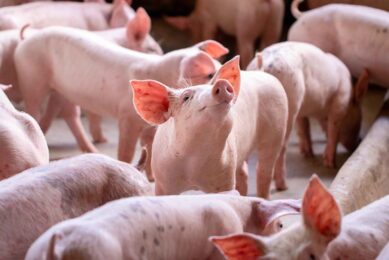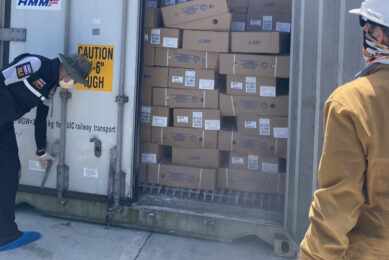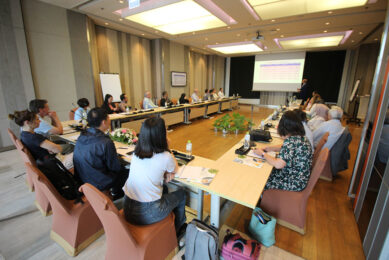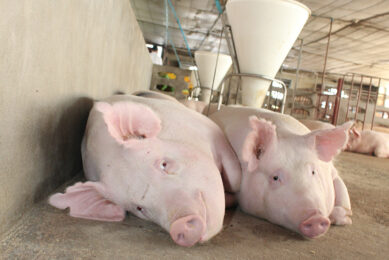Knowledge and control help fight Foot-and-Mouth in Asia
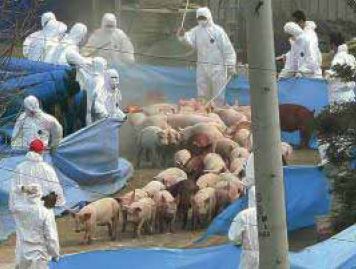
When animal suffering and destruction is numbered in millions of heads; when the financial impact is measured in billions of dollars; and where the social and emotional costs are inordinately high – the quest to improve control efforts and minimise the destructive impacts of Foot-and-Mouth Disease (FMD) are worthy priorities. At the recently held Asian Pig Veterinary Society (APVS) Congress in Pattaya, Thailand, the memory of the recent outbreak in South Korea was still fresh – hence FMD control was as topical as ever.
By Sacha Seneque, BVSc, MACVSc, Merial, Australia
The ease and often ‘explosive’ spread, the direct losses incurred and the negative effect on market
access or trade impact, make Foot-and-Mouth Disease (FMD) one of the most serious and important livestock diseases globally. Its significance in Asia is undoubtedly growing due to several factors, not the least being that:
• the disease has greater negative effects on growing populations of improved and more efficient production animals;
• there is greater risk of virus spread due to increased people movements and livestock product trade;
• there is an increasing gap between developed and developing countries in this region.The result is that the world nowadays is faced with a situation where increased populations of concentrated and highly susceptible animals are having greater risks of being exposed to FMD virus (FMDV). FMDV (Aphtae epizooticae) is a highly variable and transmissible virus, usually capable of infecting a range of ruminants and swine. The virus has a discrete range of serotypes (seven are known to exist) and several subtypes, each with an ability to continually evolve and mutate contributing to wide genetic and antigenic variation. Different host species (and even different breeds) may exhibit varying disease susceptibility during any prevailing outbreak/epizootic. Viral transmission occurs in many ways:- animal to animal (including through semen and milk);
– aerosol ‘wind borne’ spread;
– by non-affected host animals (including humans);
– by animal products.
– contaminated housing, material, clothing, water, soil and inanimate objects (such as fodder and vehicles), as well other mechanical vectors.The epidemiology of FMD in Asia is influenced by a combination of factors. This includes: a variation in the virus strain, the consistency of effective control measures and new strain introductions (originating from distant outbreaks that are transmitted via animal movement or other mechanisms) to susceptible populations.
Seasonal and cyclic periods of increased disease prevalence are observed, suggesting that there are factors that favour periods of increased transmission or host susceptibility that predispose epizootic risk. The following is an attempted summary of the prevailing state of play in Asia.
Distribution of FMD viruses
Today, serotypes O, A & Asia 1 are considered endemic in one or more of the FMD affected countries in Asia, with Type C having last been reported in the Philippines in 1995. Although in recent years there has been a general increase in disease reporting transparency, field surveillance, outbreak investigation and field isolate studies, the submission of virus samples for processing and analysis by central reference bodies such as the World Reference Laboratory (WRL) or South East Asian Regional Reference Laboratory (RRL) have been irregular. Consequently available information may not be comprehensive or complete.
Serotype O
Over the past 15 years, there have been three distinct groupings (‘topotypes’ or ‘lineages’) of Type O identified in Asia. They are South East Asia (SEA), pan-Asia, and Cathay (‘pig-adapted’) strains. Subfamilies exist for both the SEA and pan-Asia topotypes. In recent years, Type O strains have been responsible for the most severe epidemics experienced in Asia: Cathay lineages in the Philippines ’94, and Taiwan ’97; Asian/UK epizootics of O pan-Asia in 2000/01; and SEA lineage in Indochina ’97 and more recently Hong Kong, Japan, Korea ’09/10.
Serotype A
Is potentially the most variable of all the FMD serotypes, and although historically outbreaks have occurred in many Asian countries, they are more common in Thailand and Malaysia where endemic virus circulation in ruminant populations is likely to occur. Recent outbreaks are restricted to the SEA topotype which has exhibited some antigenic drift. The most recent epidemic occurred in ’09/’10 and included a disease incursion into then FMD free South Korea which was successfully controlled. Ongoing vigilance for new A strains introductions or strain variants is important due to relatively higher risk of antigenic changes/differences being encountered.
Serotype Asia 1
Is the most antigenically stable of the three endemic serotypes and has been shown to exhibit relatively low levels of antigenic variation however is still capable of antigenic drift. Various historical epizootics have been reported, mainly affecting some South East Asian countries. Cases appear to have a cyclical prevalence pattern, with the most recent epizootic affecting the SEA and Greater China geographies in the 2004-2006 period.
Virus spread
It is accepted that the most important endemic mechanism of virus spread in Indochina countries is by live animal movement, both within disease affected countries and across borders. This is largely driven by the economics of trade. Cattle, buffalo or pig movements are the source (or implicated) in most cases, and well documented trading patterns that reflect local demand have a high correlation to outbreak risk factors and disease ‘hotspots’ in the Indochina region.
Although not definitive, there are instances where genetic analysis of outbreak isolates has implicated animal products (meat) as the likely source of new strain introductions into this region, and between countries. In the absence of other possible sources, the many bio-security failures observed over recent years suggests that people have been responsible for transferring FMD between farms; this may prove to be an important and underestimated transmission risk within this region. The long-distance spread of FMD on the wind doesn’t appear to be an important source of transmission, although aerosol transmission in cases of neighbouring farm-to-farm spread is likely, especially in areas of high animal densities where pigs are involved.
Country status
National veterinary service prioritisations, control activities and prevailing needs are broadly related to country or zone FMD status. These can be distinctly grouped:
FMD free countries
Most enjoy the benefits of maintaining such a status, however as they can have large populations of naïve livestock (i.e. vaccination is not routinely practiced), the potential impact of a large or lasting disease incursion on animal populations, the society and fiscally can be very significant. Primary challenges are on reducing disease introduction risks, and ongoing ‘peace time’ development of appropriate incursion response preparedness and veterinary service capabilities. Attention is paid to: required regulatory and legal framework which facilitates quick and efficient disease identification and appropriate control responses; and the subsequent FMDV eradication validations that would be required to regain official Disease Free status, in the event of an outbreak.
FMD endemic countries
There can be two general groupings: • Countries where commercial livestock sectors and external trade opportunities are not well developed, veterinary services may be weak and FMD cases not uncommon. Locally, economic justification for the investments required for comprehensive FMD control can be poor. Often solutions fail due to significant limitations in resources, infrastructure or lack of political stability (as may occur in areas of conflict) or will. These may need to be secured before embarking on significant disease control initiatives which could be considered feasible or worthwhile. • Countries that have well developed commercial sectors with interests in securing and developing the considerable premium trade opportunities present with increased market access. Veterinary service capabilities are usually well developed, FMD control initiatives are already in place, and economic justification at a national level supports transition from comprehensive FMD control to a disease eradication phase. Primary control challenges are decreasing or maintaining low levels of endemic FMD cases and effectively controlling any epizootics; supporting evidence or risk based control initiatives; and building capabilities that support transition to successful and sustainable FMD eradication.
Vaccination
As a part of disease prophylaxis, vaccines are recognised as an important tool and play an increasingly important role in FMD control both endemic and non-endemic settings. Use of vaccines that achieve relevant ‘herd immunity’ levels of >80% in susceptible animal populations are the basis of virus transmission and disease reductions necessary to effectively aid outbreak control. Dramatic and almost complete reductions in FMD prevalence are consistently observed when appropriate vaccines are correctly employed as part of comprehensive control initiatives. This is the case in both disease endemic settings or when used strategically as an aid to outbreak control and eradication efforts. In endemic countries, FMD vaccines are often regulated to aid vaccination compliance aims and to ensure appropriate quality vaccines are used. Decreases in national FMD outbreak rates are generally correlated to increases in national herd vaccination coverage.
In Asia’s endemic countries, available FMD vaccines are routinely used in the vast majority of commercial herds (usually at the producer motivation and expense), and today more than 95% of pigs in commercial production settings are vaccinated. National animal health bodies use several mechanisms to increase overall national herd vaccination coverage, they include implementation of: mandatory vaccination; vaccine subsidies; and mass vaccination initiatives that target small land holder animal populations, specific host species or strategic ‘high risk’ geographies.
Having said this, the approach to vaccination as a control tool is not uniform between countries and the role and use of vaccines varies. Even when routinely used, there is a wide range in vaccination rates being achieved in susceptible populations between different disease endemic countries.In FMD free countries, routine use of FMD vaccination is banned (in compliance with OIE disease free status requirements). However many (but not all) disease free countries have established contingency plans that include provisions for strategic emergency vaccine use in the unfortunate case of disease incursion. To help assure timely availability of vaccines, strategic vaccine or cryostored FMD Ag Bank inventories are maintained, and relevant service/supply agreements made with vaccine providers. FMD vaccine limitations exist; vaccination with one FMD serotype does not confer cross-protection against other serotypes; additionally vaccine efficacy may vary between isolates of the same FMD serotype if antigenic diversity is great. Current vaccine technology has played a central role in successful FMD control and eradication in Asia and globally continued improvements in vaccine quality and services are being made, and research into new technologies explored in the ongoing quest to deliver more effective vaccine tools and alternatives. Understanding and mitigating limitations and utilising available disease control tools appropriately are important in the context of Asian endemic and disease-free situations.
Use of appropriately matched vaccine strains (be they homologous or heterologous), relevant to prevailing field epidemiology, and formulation of fit-for-purpose vaccines has been used to great advantage in Asia. In this respect, the ongoing activities and collaborations between national veterinary services and regulatory bodies, vaccine manufacturers, and independent bodies are playing vital roles to ensure adequate supply of vaccines (see box).
One FMD controlstrategy for SE Asia By Ronello Abila, OIE South East Asia, Bangkok, Thailand; and Wantanee Kalpravidh, Emergency Center for Transboundary Animal Diseases, Bangkok, Thailand Control of Foot-and-Mouth Disease (FMD) is critical to meet development objectives such as food security, poverty alleviation and facilitation of trade in South East Asia. Therefore, the South East Foot and Mouth Disease (SEAFMD) campaign was launched in 1997 to coordinate a subregional control of FMD. Being a transboundary animal disease, control of FMD needs close collaboration among neighbouring countries and the involvement of relevant stakeholders such as farmers and livestock traders. In 2010, China joined the campaign renaming it to South East Asia and China Foot and Mouth Disease (SEACFMD) campaign. To provide long-term guidance to the campaign, a Roadmap 2020 was launched in 2007. That time, the main strategy was the implementation of a progressive zoning approach to ensure effective use of limited resources from the donors and national governments. The campaign members reported varied reasons on the origins of each outbreak and the possible factors involved in the transmission. For Cambodia and Laos, the sources of outbreaks are unknown. In Malaysia and Vietnam it’s mainly due to illegal movement, while in Myanmar it’s due to contact with infected grazing/watering areas. In Thailand it’s mainly due to animal movement. Control measuresSeveral other steps are taken to strengthen FMD control: • Having a professional coordinationof animal health activities between countries. A coordination unit is based in Bangkok. • The campaign had a Epidemiology Network (EpiNet) and a Laboratory Network (LabNet) established to provide technical support to enhance member countries’ capacity for effective surveillance and diagnosis. • The campaign has initiated several studies, in collaboration with partner organisations, to identify risk pathways and critical nodes along the livestock movement, apply social network and stakeholder analysis to identify key players along the pathways, and come up with regulatory and non-regulatory recommendations to reduce risks. • Vaccinationis recognised as an important tool, but resource deficit in countries such as Cambodia, Laos and Myanmar, cause very limited access to good quality vaccines. • Communication and public awareness campaigns are essential components for effective control of FMD to ensure public support and political commitment from the government. • Continued political commitment, coupled with proper allocation of needed resources from each member country. |
Source: Pig Progress magazine Volume 27. No. 4



